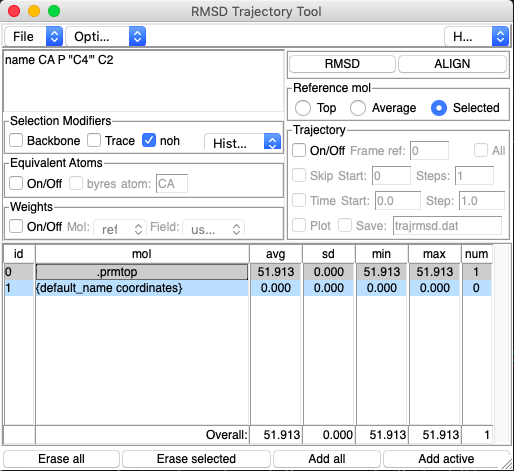

The score and abinitio routines assume that there is a 1-to-1 relationship between the residues in the two poses. Much more likely is that there is some sort of register shift issue going on. These rmsd routines are heavily used, so I'm somewhat doubtful that there are errors in them. (References from the code comments.) This should involve finding the optimal rotational/translational transform to superimpose the Calpha pairs, and then calculating the rmsd from that transform. The algorithm used should be the one by Wolfgang Kabsch in Acta Cryst (1976) A32 page 922 as modified by ACTA CRYST(1978) A34 PAGE 827. Unless you use the -in::file::native_exclude_res option, the score application will use the standard Calpha rmsd to the native structure (the one passed to -in:file:native). Then I calcuated the rms between the Ca atoms of smallest structures of the decoy and the native. I fitted the largest structure on its native complex. When I recalculate this rms myself in several programs (pymol, vmd) I find values of 5 A. Rosetta for example calculates rms values of 15 A between a decoy and a native. When I look in de full atom score file Rosetta produced, I see rms values that I don't understand. > I tried a pertubation run on two proteins. Apart from that pymol also tends to get rid of some residues which do not align and give RMSD of only those residues which align to some extent. Whatever RMSD you get comes only from the smaller unit of the complex. While in your method, you have superimposed the bigger structure over the native one and the RMSD for that unit will be ~0. Then rotates the decoy to get the best alignment with the native structure. It aligns the whole decoy complex over the native complex by superimposing the center of masses of both the complexes. Origin.I think Rosetta calculates the rms of a complex in a different way. If you need to plot multiple RMSD curves in the same map (as what I did in my paper), you need to make VMD export curve data for each trajectory to individual text file, then plot them together in e.g. 24 of your research paper "A thorough theoretical exploration of intriguing characteristics of cyclocarbon: Geometry, bonding nature, aromaticity, weak interaction, reactivity, excited states, vibrations, molecular dynamics and various molecular properties"Ģ Load the molecular dynamics trajectory to VMDģ Select "Extensions" - "Analysis" - "RMSD Trajectory Tool"Ĥ Input "all" in the text box at upper right corner of the GUI, then click "ALIGN" button, select "Plot" check box, then press "RMSD" button.
#VMD MEASURE RMSD HOW TO#
Sir can you please provide instruction for how to draw the figure of Root mean square deviation (RMSD) with respect to its optimized structure from AIMD simulations as shown in fig. GFN-xTB) is less reliable and accurate than B97-3c. The xtb is much faster, but the theory employed by xtb (i.e. If this calculation is too expensive for you, you can use xtb code developed by Grimme ( ) to run molecular dynamics instead. If during simulation, the system doesn't isomerize or dissociate, that means the system is stable under current simulation temperature.

The coordinate will be continuously dumped to pos.xyz in current folder during running. After properly changing it (the number of cores, memory, temperature and MD steps), you can run it by ORCA. Now you can find AIMD.inp in current folder. B97-3c is relatively cheap while reliable pdb/.xyz/.mol/.wfn.ġ // Use B97-3c for the calculation. Assume that you are using the latest version of Multiwfn, you can do this by inputting below commands in Multiwfn:Įxamples\CH3CONH2.fch // An example. It is doesn't matter even if you are not familiar with ORCA, because Multiwfn can easily create proper ORCA input file. If your system is an isolated cluster, although Gaussian indeed can run AIMD for it, a better choice is using ORCA, because ORCA is freely available, faster, and meantime its AIMD function is easier to use. If it is a periodic system, you are unable to use Gaussian to perform AIMD for it, because despite that Gaussian supports periodic boundary condition (PBC) calculation, the speed is extremely slow, it is best to use first principle codes such as CP2K and Quantum Espresso to do the AIMD. I don't exactly know what the 2D structure you are studying.


 0 kommentar(er)
0 kommentar(er)
